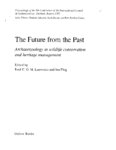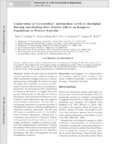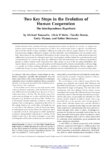Filters: Department: "Anthropology" School Or College: "College of Social & Behavioral Science" Collection: "ir_uspace"
1 - 25 of 21
| Creator | Title | Description | Subject | Date | ||
|---|---|---|---|---|---|---|
| 1 |
 |
O'Rourke, Dennis H. | South from Alaska: a pilot aDNA study of genetic history on the Alaska Peninsula and the Eastern Aleutians | Abstract The Aleutian Islands were colonized, perhaps several times, from the Alaskan mainland. Earlier work documented transitions in the relative frequencies of mtDNA haplogroups over time, but little is known about potential source populations for prehistoric Aleut migrants. As part of a pilot i... | 2010 | |
| 2 |
 |
O'Rourke, Dennis H. | Unangan past and present: the contrasts between observed and inferred histories | Abstract Academic research focusing on the population and culture history of the Aleut (Unangan) people began in the late 19th century and continues to the present. The papers in this special issue of Human Biology summarize the latest results from archaeological, linguistic, genetic, and morphometr... | 2010 | |
| 3 |
 |
Broughton, John | Pristine benchmarks and indigenous conservation? Implications from California zooarchaeology | The superabundance of tame wildlife during the early historic period in California astonished European explorers. And the historic accounts of incredible animal densities, most notably artiodactyls, have influenced a long-held perception that California Indians lived in harmony with nature. However,... | 2004-01-01 | |
| 4 |
 |
O'Rourke, Dennis H. | Spatial and temporal stability of mtDNA haplogroup frequencies in native North America | Mitochondrial DNA lineage frequencies in prehistoric Aleut, eastern Utah Fremont, Southwestern Anasazi, Pyramid Lake, and Stillwater Marsh skeletal samples from northwest Nevada and the Oneota of western Illinois are compared with those in 41 contemporary aboriginal populations of North America. T... | Mitochondrial DNA; Lineage variation; Haplogroup assignment | 2000 |
| 5 |
 |
Codding, Brian | Conservation or co-evolution? Intermediate levels of aboriginal burning and hunting have positive effects on kangaroo populations in Western Australia | Studies of conservation in small scale societies typically portray indigenous peoples as either sustainably managing resources, or forsaking long-term sustainability for short-term gains. To explain this variability, we propose an alternative framework derived from a co-evolutionary perspective. In ... | 2014-01-01 | |
| 6 |
 |
Cashdan, Elizabeth A. | Ethnocentrism and xenophobia: a cross-cultural study | Analyzes the factors influencing ethnic affiliation and interethnic hostility. Relationship between intraethnic loyalty and risk of famine; Continuity of violence at different levels of groupings; Analysis of local and intercommunity conflict. | Ethnic relations; Ethnology | 2006-06-06 |
| 7 |
 |
Codding, Brian F. | Explaining prehistoric variation in the abundance of large prey: a zooarchaeological analysis of deer and rabbit hunting along the Pecho Coast of Central California | Three main hypotheses are commonly employed to explain diachronic variation in the relative abun dance of remains of large terrestrial herbivores: (1) large prey populations decline as a function of anthro pogenic overexploitation; (2 ) large prey tends to increase as a result of increasing social p... | Foraging; Resource depression; Prestige hunting; Paleoclimatic variability; Human behavioral ecology; Zooarchaeology; Central California | 2009-11-14 |
| 8 |
 |
Hawkes, Kristen | Hunting and the evolution of egalitarian societies: lessons from the Hadza | Political hierarchies are common in human societies but absent among many mobile hunter-gatherers. So egalitarian social organizations have been attributed to limits that foraging imposes on wealth accumulation. But male-dominance hierarchies characterize all the great apes, our nearest relatives. ... | 2000 | |
| 9 |
 |
Rogers, Alan R. | Quantitative genetics of sexual dimorphism in human body size | A classical data set is used to predict the effect of selection on sexual dimorphism and on the population means of three characters--stature, span, and cubit--in humans. Given selection of equal intensity, the population means of stature and of cubit should respond more than 60 times as fast as d... | Societies; Selection; Species | 1992 |
| 10 |
 |
Rogers, Alan R. | Genetic variation at the MCIR Locus and the time since loss of human body hair | The melanocortin I receptor (MCIR) locus makes a protein that affects the color of skin and hair. At this locus, amino-acid differences are entirely absent among African humans, abundant among non-Africans (especially Europeans), and abundant in chimpanzee/human comparisons (Rana et al. 1999, Hardin... | Nonsynonymous; Chimpanzee; Constraint | 2004 |
| 11 |
 |
Rogers, Alan R.; Harpending, Henry C. | Mismatch distributions of mtDNA reveal recent human population expansions | Although many genetic studies of human evolution have tried to make distinctions between the replacement and the multiregional evolution hypotheses, current methods and data have not resolved the issue. However, new advances in nucleotide divergence theory can complement these investigations with a ... | 1994 | |
| 12 |
 |
Hawkes, Kristen | Hadza scavenging: implications for Plio/Pleistocene Hominid subsistence | The frequent association of stone tools and large animal bones in African Plio/Pleistocene archaeological sites has long been taken as evidence of the importance of hunting in early hominid diets. Many now argue that it reflects hominid scavenging, not hunting. | Hadza; Scavenging; Plio/Pleistocene; Hominid Diet | 1988-04 |
| 13 |
 |
Codding, Brian F. | Interpreting abundance indices: some zooarchaeological implications of Martu foraging | Indices of taxonomic abundance are commonly used by zooarchaeologists to examine resource inten sification, overexploitation and gender divisions in foraging labor. The original formulation of abundance indices developed a clear interpretive framework by linking the measure with foraging models from... | Human behavioral ecology; Zooarchaeology; Ethnoarchaeology; Resource intensification; Gender division of labor; Western Australia | 2010-07-20 |
| 14 |
 |
Hawkes, Kristen | Why hunter-gatherers work: An ancient version of the problem of public goods | From the abstract: People who hunt and gather for a living share some resources more widely than others. A favored hypothesis to explain the differential sharing is that giving up portions of large, unpredictable resources obligates others to return shares of them later, reducing everyone's variance... | Hunter-gatherer societies; Public goods | 2001-08 |
| 15 |
 |
Wiessner, Pauline W. | Wealth transmission and inequality among hunter-gatherers | We report quantitative estimates of intergenerational transmission and population-wide inequality for wealth measures in a set of hunter-gatherer populations. Wealth is defined broadly as factors that contribute to individual or household well-being, ranging from embodied forms, such as weight and h... | 2010-02 | |
| 16 |
 |
Hawkes, Kristen | Stag hunts or rearing environments? | Tomasello et al. have made the case that shared intentionality distinguishes humans from our nearest living relatives. What accounts for the difference? The answer they offer is Stag Hunt choices faced by ancestral foragers. Noting problems with that answer, I urge attention to a promising alternati... | 2012-01-01 | |
| 17 |
 |
Rogers, Alan R.; Jorde, Lynn B. | Origins and affinities of modern humans: a comparison of mitochondrial and nuclear genetic data | To test hypotheses about the origin of modern humans, we analyzed mtDNA sequences, 30 nuclear restriction-site polymorphisms (RSPs), and 30 tetranucleotide short tandem repeat (STR) polymorphisms in 243 Africans, Asians, and Europeans. An evolutionary tree based on mtDNA displays deep African branch... | Base Sequence; Variation (Genetics); Base Sequence | 1995 |
| 18 |
 |
Rogers, Alan R.; Harpending, Henry C. | Genetic structure of ancient human populations | Discusses mitochondrial DNA (mtDNA) sequences as important source of data about the history of human species. | Tree of descent; Mismatch distributions; Simulations; Findings; Intermatch distributions; Younger and older populations | 2001-09-15 |
| 19 |
 |
Hawkes, Kristen | Alyawara plant use and optimal foraging theory | Various authors have remarked on the importance of seeds in the pre-European diet of central Australian Aborigines. The Alyawara, an Arandic-speaking group, were typical in this respect. They collected edible seeds from nearly half the eighty-five plant species in their traditional subsistence inven... | Australia; Aborigines; Foraging; Seeds | 1981 |
| 20 |
 |
Hawkes, Kristen | Hadza women's time allocation, offspring provisioning, and the evolution of long postmenopausal life spans | Extended provisioning of offspring and long postmenopausal life spans are characteristic of all modern humans but no other primates. These traits may have evolved in tandem. Analysis of relationships between women's time allocation and children's nutritional welfare among the Hadza of northern Tanza... | Child care; Children, nutrition; Life spans, Biology; Mother & child; Primates; Social structure; Women; Time Management; Hominids | 1997 |
| 21 |
 |
Broughton, John | Prehistoric human impacts on California birds: evidence from the Emeryville Shellmound Avifauna | The abundance of artiodactyls, marine mammals, waterfowl, seabirds, and other animals in 18th- and 19th-century California astonished early explorers, and the incredible wildlife densities reported in their accounts are routinely taken as analogues for the original or pristine zoological condition. ... | Avifauna; Prehistoric hunting; Biological evaluation of environmental impacts | 2004 |
1 - 25 of 21
